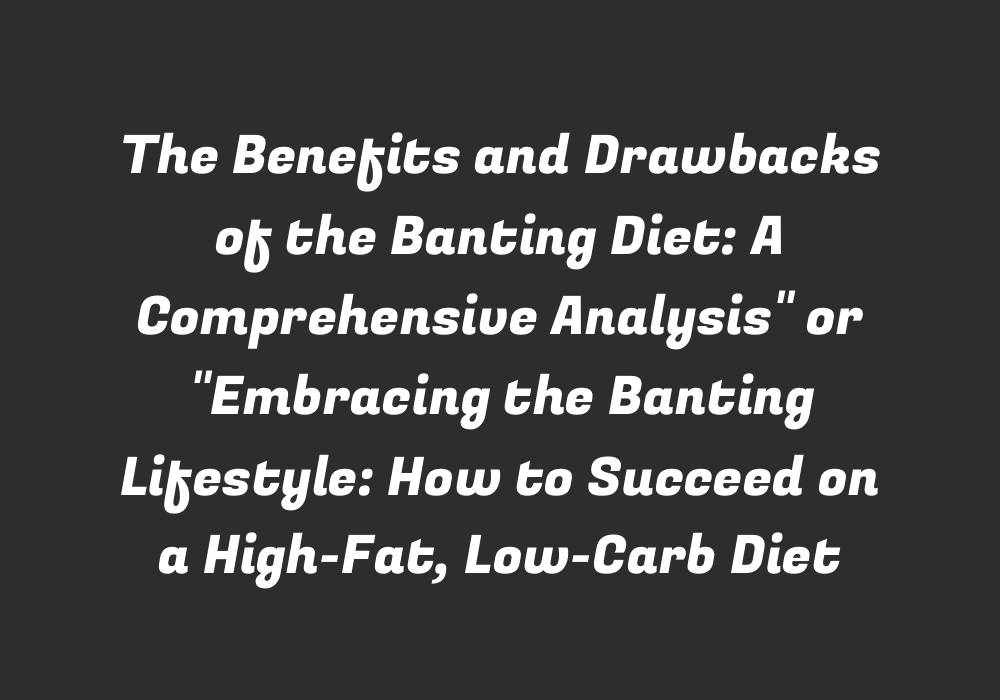Embracing the Banting Lifestyle: How to Succeed on a High-Fat, Low-Carb Diet
Introduction
The Banting diet, also known as the LCHF (Low-Carb, High-Fat) diet or the Keto diet, has gained popularity over recent years. It’s named after the British physician William Banting who first advocated for the benefits of limiting carbohydrate intake while focusing on higher fat and protein consumption in his 1863 book “Letter on Corpulence.” This high-fat, low-carb dietary approach has been linked to various health benefits and weight loss. However, it’s crucial to weigh the advantages and disadvantages before adopting this lifestyle change. This article will explore both sides of the Banting diet in detail to help you make an informed decision.
Benefits
1. Weight Loss: One of the most notable benefits of the Banting diet is its potential for rapid weight loss. By reducing carbohydrate intake and focusing on healthy fats, your body enters a state called ketosis where it burns stored fat as fuel instead of glucose. This process can lead to significant weight reduction within a short period, making the Banting diet popular among individuals looking for quick results.
2. Improved Blood Sugar Control: The Banting diet has been shown to positively impact blood sugar levels and insulin sensitivity. With its low-carbohydrate structure, it can effectively decrease blood glucose spikes that often accompany high-carbohydrate meals. As a result, individuals with diabetes or prediabetes may find the Banting diet beneficial in managing their blood sugar levels and reducing reliance on medication.
3. Enhanced Heart Health: The high-fat content of the Banting diet encourages the consumption of healthy fats, which are essential for overall heart health. Fats like monounsaturated and polyunsaturated fatty acids found in avocados, nuts, seeds, and oily fish help reduce bad cholesterol levels and increase good cholesterol. This can lead to improved cardiovascular function and a lower risk of heart disease.
4. Increased Energy and Focus: The Banting diet emphasizes consuming more proteins and fats, which provide sustained energy compared to the quick bursts of energy from carbohydrates. Many people report feeling less tired, having enhanced mental clarity, and experiencing fewer sugar cravings while following this diet.
5. Greater Satiety: The Banting diet’s high-fat content can help individuals feel fuller for longer periods due to the slow digestion of fat. This can lead to reduced appetite and better control over food cravings, ultimately supporting weight loss efforts.
6. Reduced Inflammation: High-carbohydrate diets are often associated with increased levels of inflammation in the body. The Banting diet’s low-carbohydrate nature can help reduce this inflammation, which may improve various health conditions like arthritis and chronic pain.
Drawbacks
1. Initial Difficulty: One common challenge people face when transitioning to the Banting diet is navigating the change in eating habits, especially for those accustomed to a high-carbohydrate diet. It may require some time to adapt to consuming higher amounts of healthy fats and proteins while reducing carbohydrates.
2. Potential Negative Impact on Gut Health: The Banting diet emphasizes increasing fiber intake, primarily through non-starchy vegetables, but its overall high-fat content may not provide sufficient prebiotic fiber to nourish the gut bacteria adequately. This could potentially lead to imbalances in gut flora, which may have implications for digestive health and overall well-being.
3. Risk of Nutritional Deficiencies: While the Banting diet focuses on whole foods that contain essential vitamins and minerals, there is a risk of nutritional deficiencies if individuals do not adequately plan their meals. Low intake of certain carbohydrates can result in lower levels of folic acid, which is crucial for cell division and tissue growth. Additionally, the focus on high-fat foods may lead to insufficient intake of vitamin C, calcium, or magnesium, among other essential nutrients.
4. Cost: The Banting diet can be more expensive than a traditional balanced diet due to its emphasis on healthier fats and proteins. Nuts, seeds, avocados, olive oil, grass-fed meats, and other high-quality ingredients may require a larger investment in groceries.
5. Social Aspects: Eating out or attending social gatherings can be challenging when adhering to the Banting diet due to limited menu options. It’s essential to consider the availability of suitable food choices in various settings to ensure successful long-term compliance.
6. Potential Effect on Kidney Function: High protein consumption may put additional strain on the kidneys, especially for those with existing renal issues or predispositions. People with a history of kidney stones should also exercise caution when consuming increased amounts of animal protein.
Conclusion
The Banting diet offers numerous potential health benefits, including weight loss, improved blood sugar control, and heart health, among others. However, it is essential to be aware of the drawbacks, such as difficulty adjusting eating habits, potential risks to gut and kidney function, nutritional deficiencies, and social aspects that might make long-term compliance challenging. A well-planned approach with professional guidance can help individuals achieve success on a Banting diet while addressing any concerns that may arise.
